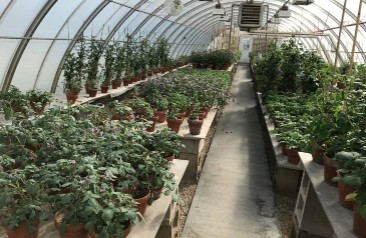The potato is the number one vegetable consumed by Americans. It is an excellent source of potassium, contains 45 percent of the recommended daily amount of Vitamin C and provides all essential amino acids.

But could the nutritional value of potatoes be improved? That is what U.S. Department of Agriculture research geneticist Kathy Haynes has been asking for nearly 30 years. Her quest for the answer has led her to breeding a more nutritious potato, similar to the papa criolla types found in South America.
Haynes’ quest has also led to a collaboration with New Mexico State University for field trials to see if the new lines of potatoes can be raised in New Mexico as a specialty crop.
“When Dr. Haynes contacted us, I was very excited,” said Stephanie Walker, NMSU Extension vegetable specialist and researcher. “Potatoes are the most widely consumed vegetable, but are low in the antioxidant compounds that are found in the papa criolla types. This research is taking a vegetable that is already loved by people and then making it even more nutritious.”
White-fleshed potatoes typically grown in the United States are low in carotenoids that act as antioxidants for healthy eyes. The most well-known carotenoid is beta-carotene found in carrots.
The carotenoids in the South American papa criolla potatoes, which make the potato yellow-fleshed, are lutein and zeaxanthin, which help prevent age-related macular degeneration. At least one study has suggested that zeaxanthin also improves mental acuity in elderly people.
“Yukon Gold, a yellow-flesh potato that consumers are familiar with, has these carotenoids,” Haynes said. “Comparatively, the papa criolla types have 10-20 times more lutein and zeaxanthin than Yukon Gold.”
The best food sources of lutein and zeaxanthin currently in U.S. markets are the dark leafy greens collards, kale and spinach.
Haynes has used traditional breeding to develop the papa criollas into a potential commercial potato. Starting with germplasm from Peru, she developed more than 500 breeding lines of the potato during a multiple-year process.
“At first the plants were only producing pea-size tubers,” she said. “But through our breeding process we now have tubers about the size of a golf ball or larger.”
In 2014, after selecting 500 breeding lines with possible commercial traits in her Maine breeding plots, Haynes sought collaboration with NMSU and the University of Florida to conduct field trials in areas with sizable Hispanic populations, hoping to generate interest among people already familiar with papa criolla type potatoes.
Walker planted several hundred breeding lines in Las Cruces and Los Lunas in 2015 and 2016, and helped whittle that number down to 150 in 2016. From the harvest data, about 40 breeding lines are scheduled for continued evaluation in 2017.
“We also plan to plant about 6-10 breeding lines next spring in spacing trials to begin developing production recommendations for growers.
Walker says they have already learned that Las Cruces may be too warm for growing the potatoes.
“The plants were highly stressed from the heat in late spring and the tubers did not develop for many of the lines,” Walker said. “However, the lines that did produce a good yield of tubers in Las Cruces may be the basis for breeding lines more tolerant of the conditions in southern New Mexico.”
Walker has great interest and passion for pursuing new and unusual vegetables for New Mexico growers and consumers.
“This kind of crop could really be popular with growers’ market consumers who are looking for new and exciting vegetables,” Walker said.
Haynes said the papa criolla types could be popular with two consumer groups.
“The Hispanic population is increasing in the United States and they are very familiar with this potato from their homeland,” Haynes said. “It also will appeal to other consumers who associate color with good nutrition.”
Source: nmsu.edu